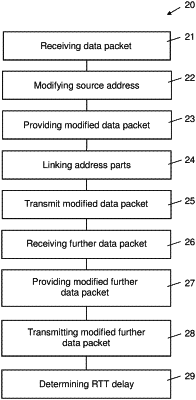| CPC H04L 47/283 (2013.01) [H04L 47/193 (2013.01); H04L 61/00 (2013.01); H04L 61/2514 (2013.01); H04L 69/163 (2013.01); H04W 80/04 (2013.01)] | 25 Claims |

|
1. A method of determining a passive Round Trip Time (RTT) delay in a telecommunications system for exchanging data packets in accordance with a data transmission protocol between a first device and a second device operatively connected to the telecommunications system, wherein the first device is identified by a first device identification, wherein the second device is identified by a second device identification, wherein the data packets comprise an address part including a source address and a destination address, the method comprising:
receiving, by a node in the telecommunications system, a data packet including an encrypted payload and originating from the first device and directed to the second device, the address part of the data packet comprising the first device identification as source address and the second device identification as destination address;
modifying, by the node, the first device identification of the source address of the received data packet;
modifying, by the node, the received data packet having an address part comprising the modified first device identification as source address and the second device identification as destination address to provide a modified data packet including the encrypted payload;
linking, by the node and in an address translation table, the address part of the received data packet with the address part of the modified data packet;
transmitting, by the node and at a first point in time, the modified data packet to the second device;
receiving, by the node and at a second point in time and from the second device, a response data packet, the response data packet having an address part comprising the modified first device identification as destination address and the second device identification as source address;
modifying, by the node, the received response data packet having an address part comprising the first device identification as destination address and the second device identification as source address, using the address translation table, to provide a modified response data packet;
transmitting, by the node, the modified response data packet to the first device; and
determining, by the node, the RTT delay from the first and second points in time.
|